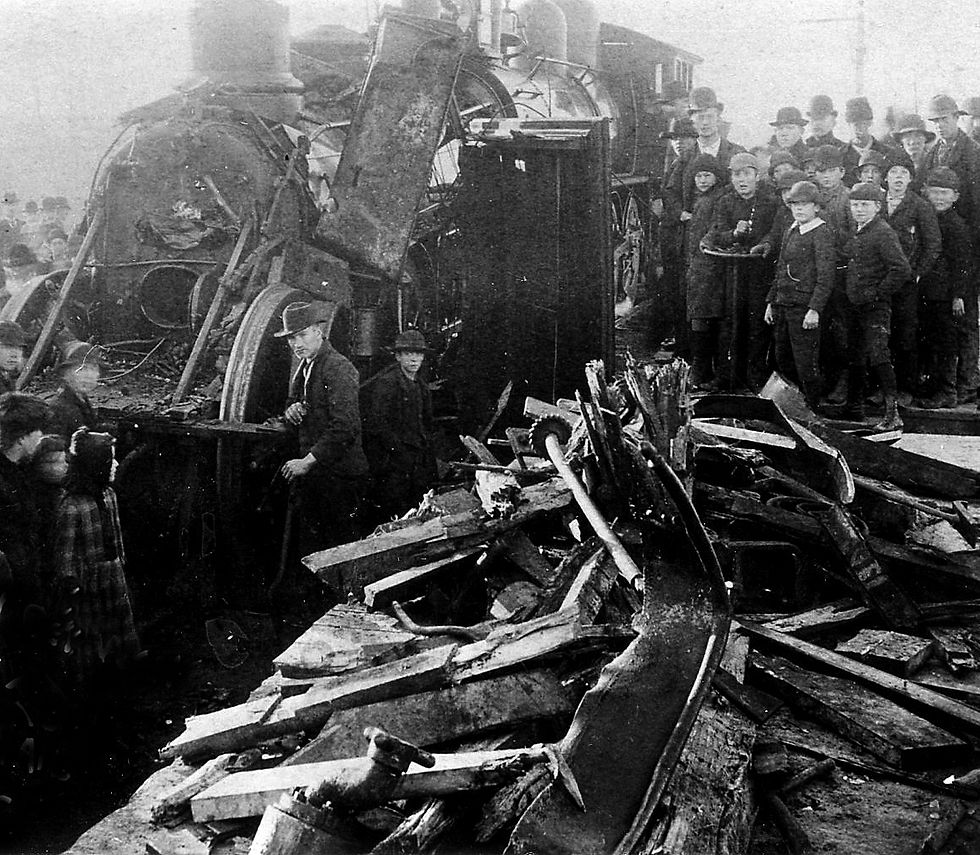Train Wreck at the Kankakee Bridge
- jwklasey
- Aug 29
- 3 min read

Debris from the tender and the engineer's cab is piled in the foreground of this wreck photo, probably taken on the afternoon of November 22, 1890. The fast mail locomotive, with the demolished cab removed, is in the foreground, while the New Orleans Express locomotive is visible in the background. Both locomotives remained upright following the crash. (Kankakee County Museum Photo Archive)
By Jack Klasey
August 30, 2025
"Fast Mail Wrecked" read the small one-column heading on page 1 of the Kankakee Gazette on November 27, 1890. Considering that the head-on collision between two trains killed one man and seriously injured another, the story might seem to be seriously underplayed.
The less-than-sensational treatment was due, primarily, to the fact that it was "old news." The Kankakee Gazette was issued weekly on Thursdays, and the train wreck had occurred the preceding Saturday, November 22. Even though the report was late, it was thorough and detailed:
"The Illinois Central fast mail going south at 5 a.m. last Saturday ran, head-on, into the New Orleans express which stood on the north-bound track at the south end of the Kankakee bridge waiting for it to pass. Fireman William Hosler, of Chicago, was instantly killed and engineer Ed Barker maimed for life."
The account of the collision continued for nearly two full columns on the newspaper's front page. It described the unusual track configuration that allowed the smaller, lighter engine of the mail train to slam head-on into the larger and heavier locomotive of the northbound passenger train. A key factor was the narrow iron bridge, built in the 1860s, which allowed only a single train to cross at any one time:
"The double track virtually commences at this end of the bridge, but the narrowness of the structure requires that the two lines of rails be laid one within the other until the south end of the bridge is reached when the southbound track, which has recently been laid, swerves off and takes its proper place beside the old track. The switch-tender...is entrusted with the duty of keeping the trains crossing the bridge on their respective lines of rails...."
Most of the blame for the crash was placed on Pat O'Neil, the switch-tender on duty, who had failed to reset the track switch after a northbound train crossed the bridge hours earlier.
After the southbound fast mail train crosses the bridge, moving at about 30 miles per hour, engineer Ed Barker discovers too late that he is heading directly for the halted New Orleans express. He applies his air brakes, but the distance is too short to stop the train. The two trains meet with a deafening crash that rocks the heavier express locomotive backward a short distance, but causes little damage to it. The effect on the fast mail, with a locomotive that weighs only about half as much, is far more serious.
The Gazette reported that "The terrible feature of the accident is seen in cab of 1303 (the fast mail locomotive). The loaded tender crunches through it as though it were an eggshell, and stops close against the boiler head." The tender slamming forward into the engineer's cab crushes fireman William Hosler to death against the boiler. Engineer Barker is badly injured, with his left leg amputated below the knee, and his collarbone and right arm broken.
As passengers pour out of the New Orleans express to see what had happened, Barker is pulled from the wreckage by brakeman W.E. Kemp. The injured engineer is placed aboard the last car of the fast mail train, which had remained on the tracks. The car is uncoupled, and moved back across the bridge to the Kankakee station.
Barker is then carried to the Commercial Hotel, across East Avenue from the station, where several local physicians attended to his injuries. The Gazette reported that Barker had been with the Illinois Central for a quarter century, and that he "stands high as an engineer...being above the average grade of railroad employee. He will receive the best of care, and is expected to pull through."
Employment on fast mail trains could be hazardous: the two railway mail clerks aboard Barker's train had survived a similar collision in Chicago two weeks earlier; one of them told the Gazette that the Kankakee accident was the eleventh wreck he had been in during his career.
The newspaper termed the collision at the south end of the Kankakee bridge an "unnecessary accident" that was due "indirectly to the mad rush of modern life which refuses to take into account the possibilities of mistakes and failures."
Jack Klasey is a former Journal reporter and a retired publishing executive. He can be contacted at jwklasey@comcast.net.






Comments